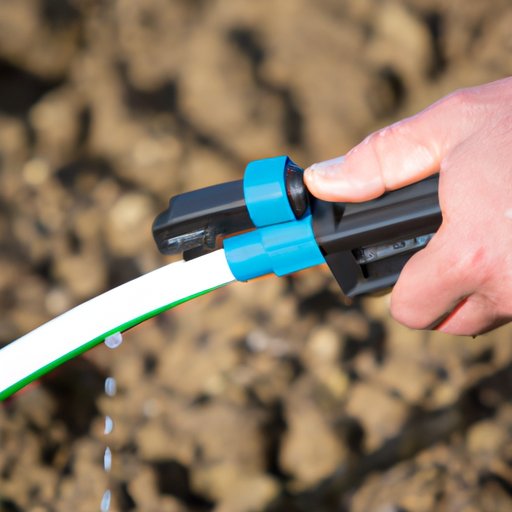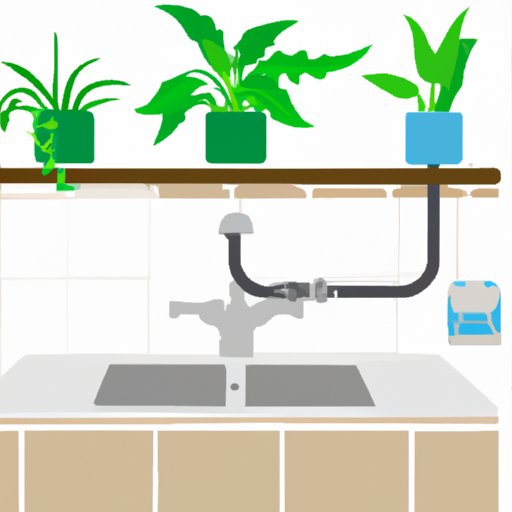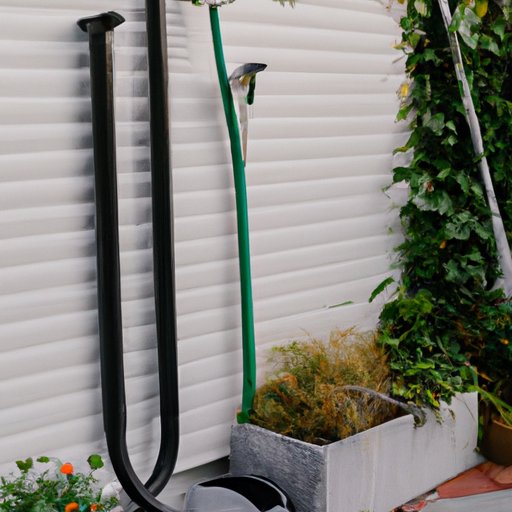Introduction
Going on vacation is exciting, but if you’re a plant parent it can also be worrying. After all, who will water your plants when you’re gone? Fortunately, there are several ways to ensure that your plants stay healthy and hydrated even when you’re away. Read on to learn how to keep your plants watered while you’re on vacation.

Install an Automatic Irrigation System
One of the best ways to keep your plants watered while you’re on vacation is to install an automatic irrigation system. This type of system uses a timer to turn on and off the water supply to your plants at predetermined times. Here are some benefits of an automatic irrigation system, as well as instructions for setting one up.
Benefits
The main benefit of an automatic irrigation system is that it eliminates the need for manual watering. You won’t have to worry about remembering to water your plants before you leave, or asking someone else to do it for you. An automatic irrigation system also ensures that your plants get the exact amount of water they need, without any risk of overwatering.
Types of Systems
There are two main types of automatic irrigation systems: underground systems and above-ground systems. Underground systems are installed beneath the soil and are connected to a water source, such as a hose or faucet. Above-ground systems are installed above the soil and use gravity to deliver water to the plants.
Installation Instructions
Installing an automatic irrigation system requires some technical know-how, so it’s best to hire a professional for the job. The installation process will depend on the type of system you choose, but generally it involves digging trenches for the pipes, connecting the pipes to a water source, and installing the timer. Once the system is installed, you can program it to water your plants at certain times of day.
Create a Self-Watering System
Another way to keep your plants watered while you’re away is to create a self-watering system. This type of system uses a reservoir of water that slowly releases moisture to the plants over time. Here’s what you need to know about self-watering systems, including the benefits and setup instructions.
Benefits
A self-watering system is a great option if you don’t want to install an automatic irrigation system. It’s also less expensive and easier to set up than an automatic system. Plus, a self-watering system ensures that your plants get a steady supply of water, so you won’t have to worry about them drying out while you’re away.
Types of Systems
There are two types of self-watering systems: wicking beds and capillary mats. Wicking beds are large containers filled with soil and water. The water is slowly wicked up into the soil, which then feeds the plants. Capillary mats are pieces of fabric that are placed on top of the soil. The fabric absorbs water, which then moves up through the soil and feeds the plants.
Setup Instructions
Setting up a self-watering system is fairly simple. First, fill the container or mat with water. Then, place the container or mat in the soil near your plants. Make sure that the container or mat is level with the soil so that it can absorb water evenly. Finally, add mulch around the container or mat to help retain moisture.
Ask a Friend or Family Member to Care for Your Plants
If you don’t want to install an irrigation system or create a self-watering system, you can always ask a friend or family member to care for your plants while you’re away. Here are some benefits of having someone else take care of your plants, as well as tips on finding help.
Benefits
Having someone else take care of your plants while you’re away is a good option if you don’t want to go to the trouble of installing an irrigation system. It’s also a great way to ensure that your plants get the attention they need, since it’s difficult to replicate the experience of human interaction.
How to Find Help
The best way to find someone to care for your plants while you’re away is to ask friends or family members who live nearby. You can also try posting a request on a local online community or social media group. Be sure to provide clear instructions on how to care for your plants, as well as a list of plants and their individual needs.
Water Before You Go
Another way to keep your plants watered while you’re away is to water them thoroughly before you leave. Here are some benefits of pre-watering, as well as tips on how to do it properly.
Benefits
Pre-watering your plants before you go on vacation is a good way to ensure that they stay hydrated while you’re away. It’s also relatively quick and easy, so it’s a good option if you’re short on time.
How to Water
When pre-watering your plants, it’s important to use the right amount of water. Too much water can drown the roots, while too little water can cause the plants to dry out. To determine the right amount of water, check the soil moisture level with your finger or a moisture meter. If the soil is dry, give the plants a deep watering until the soil is saturated. Make sure to water the roots, not the leaves.
Use Soil Moisture Sensors
Another way to keep your plants watered while you’re away is to use soil moisture sensors. These devices measure the moisture content of the soil and alert you when the plants need to be watered. Here’s what you need to know about soil moisture sensors, including the benefits and setup instructions.
Benefits
Soil moisture sensors are a great way to monitor the watering needs of your plants while you’re away. They’re also an efficient way to conserve water, since you won’t have to guess how much water the plants need.
Types of Sensors
There are two main types of soil moisture sensors: wired sensors and wireless sensors. Wired sensors are connected to a control unit via wires, while wireless sensors use radio waves to transmit data. Both types of sensors measure the moisture level of the soil and send an alert when the plants need to be watered.
Setup Instructions
Setting up a soil moisture sensor is relatively easy. First, insert the sensor into the soil near the plants. For wired sensors, connect the sensor to the control unit. For wireless sensors, sync the sensor with the control unit. Then, program the control unit to send an alert when the plants need to be watered. You can also set the control unit to water the plants automatically.
Place Plants in Groups
Another way to keep your plants watered while you’re away is to place them in groups. This technique takes advantage of the fact that plants in close proximity tend to share moisture and nutrients. Here are some benefits of grouping plants, as well as tips on how to do it properly.
Benefits
Grouping plants is a great way to conserve water, since the plants will be able to share moisture and nutrients. It’s also a good way to reduce the amount of light each plant gets, which can help prevent some plants from getting scorched by direct sunlight.
How to Group Plants
When grouping plants, it’s important to consider the size, shape, and water needs of each plant. Generally, it’s best to group plants with similar sizes and shapes together, as this will make it easier for them to share resources. Also, make sure to group plants with similar water needs together, as this will help prevent overwatering. Finally, make sure to leave enough space between the plants so that they don’t compete for resources.

Place Plants Near Gutters or Sinks
Finally, you can keep your plants watered while you’re away by placing them near gutters or sinks. This technique takes advantage of the fact that these areas tend to collect water, which can then be used to water the plants. Here are some benefits of placing plants near gutters or sinks, as well as tips on how to position them.
Benefits
Placing plants near gutters or sinks is a great way to conserve water, as the plants will be able to access the collected water. It’s also an efficient way to water the plants, since you won’t have to lug a heavy watering can around. Plus, it’s a great way to recycle water that would otherwise be wasted.
How to Position Plants
When positioning plants near gutters or sinks, make sure to put them close enough so that they can access the collected water. Also, make sure to place the plants in an area that receives adequate sunlight, as this will ensure that they stay healthy. Finally, make sure to check the plants regularly to ensure that they’re getting enough water.
Conclusion
Going on vacation doesn’t have to mean leaving your plants behind to wither. With the right preparation and care, you can keep your plants watered while you’re away. Try installing an automatic irrigation system, creating a self-watering system, asking a friend or family member to care for your plants, pre-watering before you go, using soil moisture sensors, grouping plants together, and placing plants near gutters or sinks. With these tips, your plants will stay healthy and hydrated even when you’re away.
(Note: Is this article not meeting your expectations? Do you have knowledge or insights to share? Unlock new opportunities and expand your reach by joining our authors team. Click Registration to join us and share your expertise with our readers.)
